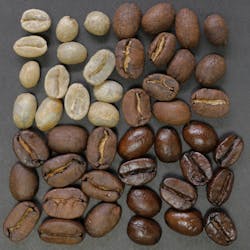The 5 Elements Of A Successful Bean-To-Cup Venture
For the last five years, bean-to-cup coffee brewers have been booming in the workplace. “It’s arguably the hottest segment in office coffee service (OCS) right now,” said Klarc Snowden, national accounts and strategic partnerships at de Jong DUKE, during the 2018 NAMA Coffee, Tea and Water show. A veteran of the bean-to-cup business, Snowden explained the strategies he implemented when selling bean-to-cup in 1998 and what he has seen earn other OCS operators top dollar.
1. Technical proficiency
Investing in technically savvy personnel is very important when running a bean-to-cup operation, stated Snowden. Companies that hire and pay a good lead technician and make training a priority are more likely to succeed. It can also be helpful to commit to one (two at most) equipment lines. Technicians can become experts on those brewers and part stocking will be less expensive. It can cost quite a bit to stock multiple equipment parts for multiple brewer lines, especially when added to the cost of the lost revenue while the machine is down while the operator waits for a part to ship.
Another aspect of the successful bean-to-cup program is to bench every machine. What Snowden means by benching is to customize a brewer at the headquarters before installing, not to get a brewer delivered to a location and set it up using the factory defaults.
“The whole beauty of bean-to-cup is that you can build a program and adjust everything,” said Snowden. If an operator is using the factory settings, they aren’t doing anything special, he went on. The brewer should be altered for the specific national coffee, local roaster, private label or whatever coffee is being served in order to bring out the best flavor and proper price per cup. Benching every machine will also alert an operator if the bean-to-cup brewer arrives damaged, which can sometime happen during shipping. This avoids the embarrassment and delaying installation at the location.
2. Financial creativity
Snowden advised operators serious about bean-to-cup programs to build a 24-month return on equipment into their pricing structure. If the cost can’t be recouped in two years, something is wrong, he says. Also, don’t be afraid of innovative pricing programs. It’s okay to let a customer lease a brewer to cover the cost.
Operators may also want to lease equipment, as it can be helpful when struggling with the substantial cash flow it takes to purchase bean-to-cup brewers. Companies that offer leasing are out there, says Snowden.
Whether an operator buys or leases equipment, keeping track of it is essential. Assest control leads to income streams. Each brewer should have a file with notes about maintenance, location, age and other essential details. Without this important log, operators can lose track of bean-to-cup brewers especially if companies they serve move or close.
3. Bold pricing
There is a saying that fortune favors the bold. With that in mind, Snowden recommends operators position themselves as the premium offering using bean-to-cup. Calling bean-to-cup premium takes the solution out of the commodity realm and into providing a service and an experience. Snowden says to quote prices by the cup, not the pound for the customers, and charge more than you think you can get. “Take the price you are afraid to charge and multiple it by 1.25,” said Snowden. “That’s a good place to start.”
He also recommends marking powders up by 100 percent and to consider charging a rental fee. A bean-to-cup brewer at a facility is a $5,000- or $6,000-dollar asset that an operator is servicing for free – that service alone is worth a rental fee, Snowden advises.
4. Differentiation
Create a coffee experience only you can deliver is Snowden’s next piece of advice. Build branded programs including creating a menu, like a coffee shop. Sell the specialty bean-to-cup program as an experience, not a product. To make this work, the coffee drinks must be good. Snowden advises investing in good powders, as they account for three-quarters of the experience and low-quality creamers, flavorings, powdered milk, etc., can cause maintenance issues in equipment. Invest in the high-grade powders made for bean-to-cup machines and charge accordingly.
5. Passion
Snowden ends with the most important aspect to winning in bean-to-cup: putting your heart and soul into the program. “If you’re not, you won’t win,” said Snowden.
Society views coffee differently than in the past. Coffee is important to people. The National Coffee Association estimates that 40 percent of the U.S. coffee being consumed is by Millennials. This is the age group driving the bean-to-cup movement and the one becoming the decision makers. To succeed, operators need to be better than their competitors in bean-to-cup sales. Providing better products and exuding passion for products helps accomplish this.
About the Author

Emily Refermat
Emily Refermat began covering the vending industry in 2006 and served as editor of Automatic Merchandiser from 2012 to 2019. To reach the current editor of Automatic Merchandiser and VendingMarketWatch.com, email [email protected].
